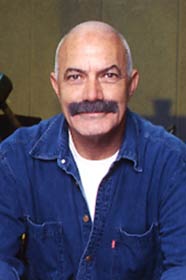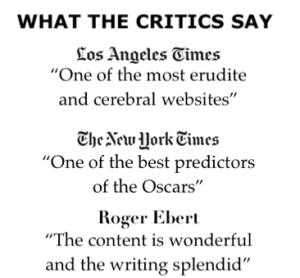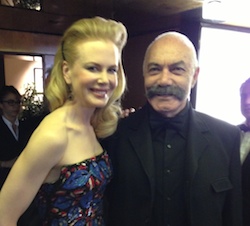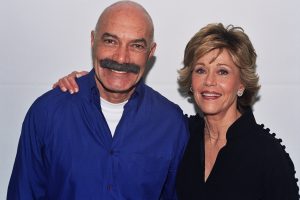The fifth and last phase of John Wayne’s career began with True Grit, for which he was honored with an Oscar Award, and ended with his last picture, The Shootist in 1976.
In these seven years, he made 12 movies, of which ten (and the first six in the l970s) were Westerns. Most of his features, such as Chisum and Big Jake, were produced by Batjac and released through Warners. Despite his age, his career was still viable and every major Hollywood studio was glad to employ him. Warners reportedly agreed to finance The Cowboys within 24 hours after the project was submitted to them, a clear indication of his firm standing at the box-office.
Wayne’s portrayal of Rooster Cogburn in True Grit was undoubtedly the climax of his professional career. His wonderful performance was unanimously praised, receiving both official recognition and the highest acting accolade, the Best Actor Oscar from the Academy of Motion Picture Arts and Sciences. But True Grit also represented, as one critic observed, “the true climax of a great and well-beloved career, if not as an actor than as an American institution.” “One can only hope that when he does decide to hang up his boots (if not his political guns!),” wrote another critic, “it will be with a vehicle as sympathetic and felicitous as True Grit.”
This prophecy turned out to be true: The Shootist was a most appropriate swan song, featuring Wayne in the mythic role of an aging gunfighter dying of cancer! He could not have appeared in a more autobiographic or reverential movie.
But there were some unfortunate projects as well, such as his attempt (the last) to expand his range in two crime thrillers|: McQ and Brannigan. Prior to that, he had never played a cop or a private eye, a genre that became extremely popular in the 1960s, with Sean Connery’s James Bond movies, and in the 1970s with Clint Eastwood’s Dirty Harry pictures. “I felt like a bit of change myself,” Wayne said, “but I had to stick to action movies, of course, and the tough cop thriller is where a lot of action is these days.” The switch to crime pictures was not by choice, however. In the 1970s, both Westerns and war movies declined in appeal, so the action-adventure was really his only viable alternative.
Unfortunately, both movies failed, critically and commercially. Comparisons with Steve McQueen (Bullitt and others) and Clint Eastwood’s vehicles were inevitable, though they were not to Wayne’s advantage. Reviewing McQ, Nora Sayre represented many critics when she wrote: “Surely Mr. Wayne should stick to Westerns; he’s simply too slow to play any kind of policeman.” And another critic went farther: “Out of the saddle and into the Hornet,” Wayne “is as stony-faced and over-aged as ever.”
But his 1970s Westerns did not feature much better, being tedious repetitions of his old formulaic films. Chisum was a traditional, old-fashioned, and conservative Western, which fictionalized as well as trivialized the real-life cattle baron to suit the actor’s persona. And Rio Lobo, the weakest Wayne-Hawks collaboration, was a feeble copy of their previous achievements in Rio Bravo and El Dorado.
As for Rooster Cogburn, it stirred a lot of interest and publicity for its casting of two legendary stars for the first time, Wayne and Katharine Hepburn. However, combining Wayne’s role in True Grit with elements of Hepburn’s spinster missionary in The African Queen, compounded with the fact that both looked old and tired, made the film an embarrassing disappointment.
In the 1970s, however, Wayne became much more than a movie superstar. He came to be regarded an American folk hero, with his off screen activities and statements getting as much publicity–at times more–as his movies. His political views, particularly his previously emotionally charged battle against Communism seemed to have mellowed, resulting in his acceptance as some kind of national treasure by most Americans, including his detractors. Wayne succeeded in becoming a popular culture figure, an icon, using a variety of mass media to promote his sociological propaganda, his version of the American Way of Life.
Thus, Wayne began to appear more frequently on television, in variety and talk shows, and starred in his first television special, Swing Out, Sweet Country, a sentimental and patriotic pastiche. His tremendous body of film work, especially his old movies, have been shown almost regularly on the small screen. Wayne even recorded an album, and later a book, America, Why I Love Her. In short, his visibility as a public figure was extraordinarily prominent, particularly following his various commercial and advertisement campaigns.
Nonetheless, in 1975 Wayne dropped out of favor as a movie star and, for the first time in 25 years, he was not among the top ten box-office stars in America. Insurance problems, stemming from his declining health, made it more difficult for studios to employ him and, more importantly, it was not easy finding suitable roles for him. Characteristically though, he did not consider retirement. During the production of The Shootist, he liked to tease reporters, “Bull! It won’t be my last picture,” reiterating his gusto for life, “Unless I stop breathing, or people stop going to see my films, I’ll be making more of them.” Indeed, shortly before his death, he was planning a new movie, a comedy titled Beau John.
But his health deteriorated rapidly: in March l978, he had bronchial pneumonia and underwent an open-heart surgery to replace a defective mitral valve. And in January l979, doctors discovered a low-grade malignant tumor in his stomach, during a gal bladder operation. His cancerous stomach was replaced with a new one, fashioned from parts of his intestines. Wayne, of course, assured his family and friends that he was fine and was going to resume his work soon–but this time he was unfortunately wrong. His last public appearance was appropriately on April 9, 1979, at the annual Oscar ceremonies, when he presented the Best Picture Award, which ironically was given to The Deer Hunter, a powerful anti-Vietnam movie. Wayne’s speech was the emotional high point of the evening and he was greeted with a lengthy standing ovation.
John Wayne died on June 11, 1979; he was seventy-two. He was buried three days later in a plot near his Newport Beach home in California. Wayne’s death marked the end of an entire era in American film. The media blitz that his death precipitated, occupying the front pages of newspapers all over the world, was a clear testament to his popularity as a movie star and to his prominence as a national legend. It is unlikely that there will ever be another American star of comparable popularity, durability, and power, in and outside the film industry.










